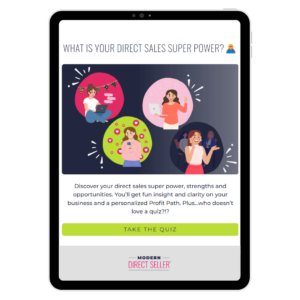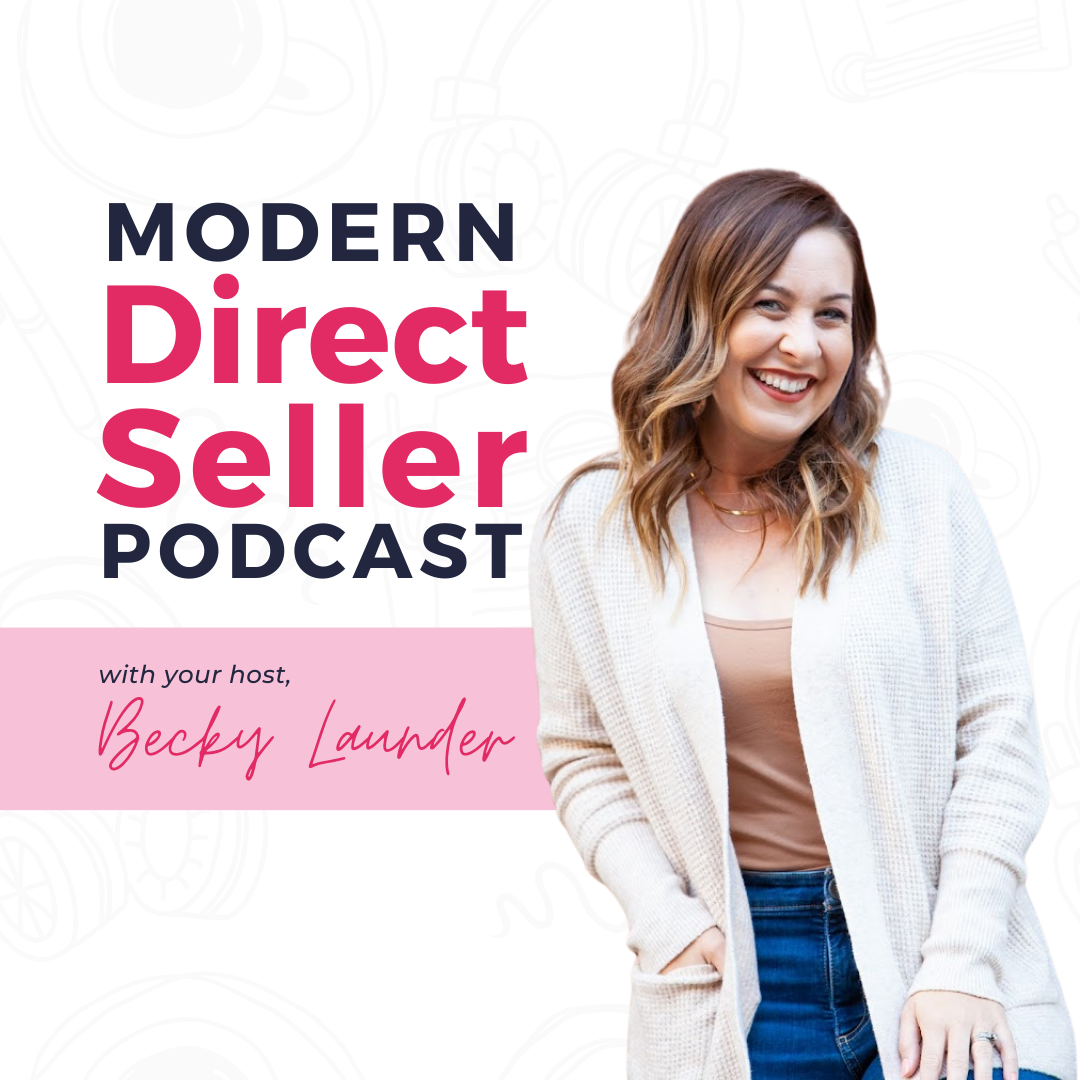Today on the Modern Direct Seller Podcast, we’re pulling back the curtain and sharing a peek at the corporate side of sales! Ben Dixon has been the CEO of NaXum for the last 10 years, and in his experience, their all-in-one platform allows companies to more seamlessly run their systems and collect the data that brings their business goals to fruition. Listen in not only for Ben’s big-picture insights into the industry, but also his ideas for individual sellers to use similar strategies to improve their personal performance and reframe the way they track their success.
Find Ben on LinkedIn, connect with the NaXum team at www.NaXum.com and www.NaXumTour.com, and learn more about the DSEF at www.DirectSellingExecutiveForum.com.
Time based notes:
- 1:32 Ben Dixon introduction
- 6:01 Considering the corporate level
- 8:52 NaXum and direct sales technology
- 12:15 NaXum’s decision-making framework
- 19:31 Transactional data and personal performance
- 23:32 Fun facts about Ben
Tech and Data for Successful Sales with Ben Dixon
Today, we’re pulling back the curtain and sharing a peek at the corporate side of sales! Ben Dixon has been the CEO of NaXum for the last 10 years, and he not only brought us his big-picture insight into how companies can more seamlessly run their systems and collect the data they need most, but also his ideas for individual sellers to use similar strategies to improve their personal performance and reframe the way they track their success.
Why don’t you tell us a little bit about your involvement in the direct sales industry? I know you’ve worn many hats over the years, and you’ve pretty much grown up in the industry. So, give us a little bit of your backstory.
I found direct selling and showed up at my first opportunity presentation as a 16-year-old kid, invited by my sister. She was a 23-year-old English teacher in Aurora, Illinois, who was, with her master’s degree, barely making $35,000 a year and said, “Man, I gotta do something more if I want to start a family and grow a life.” And so, she turned to direct sales and network marketing. And, she had a rare story. Most people don’t have a lot of success right away in the space, but she and her husband ended up making over six figures their first year. And so, I watched that as a young person and said, “Wow, is that possible in this space?” And, that’s where it all started for me. I joined on my 18th birthday—first day I legally could—to become a distributor in that company. And, I failed miserably those first 10 months. I had zero earnings for 10 months. Because, as an 18 year old, you think you know it all. I had already gone to the Super Saturdays; I had already gone to the events. And, after watching for almost two and a half years, I was saying, “Oh, I got this! I got this.” And, I did it all the wrong ways, and it took that failure to prompt me to say, “Okay, I’ve got to do this a different way.”
So, it was very humbling, but I had a very blessed comeback. The success in our family was that we ended up having a multiple six-figure income. It changed our life forever. So, my wife and I fell in love with how direct selling, when it’s done well and when it’s done right, can help families level up in their world.
So, I partnered with Rob, the founder of NaXum, way back in 2010. And, it’s been such an adventure over the last 13 years. We’ve grown as a small company in Houston, Texas, from 7 employees to over 65 full-time staff and have built over 140 direct selling companies, their platforms, everything from commission engines, to shopping carts, to marketing systems, to CRMs, to predictive platforms that feel like a top leader is sitting next to you to suggest what to do next. And, a lot of the mission today is supporting industry from the inside out. I took a backseat from being on stage and building groups and instead focused on truly working with corporate teams putting the right kinds of systems in place, so that they can get the data on what their field is willing to do, not willing to do, what’s working, what’s not working… They can make better decisions at the end of the day to support their members.
That’s so great! And, something that I think is really cool for many of our listeners that are out there in the sales field is that they might not know you. They might not know your brand. But, there are so many systems and tools and resources and incredible people behind the scenes that are partnering at the corporate level that the sales field never sees. So, I love this conversation, because I think when you’re out there selling, and you’re running parties, and you’re building your brand online, you’re not getting kind of the insights that we’re going to share here today.
So, tell us a little bit about your current role. What do you do now? Who are you serving? What kind of work are you putting out there for those that might be not in the scene of direct sales technology?
Well, my current role is as CEO of NaXum. I’ve been the CEO for the last 10 years. And, when it started, we were just making marketing systems in this space. And, we realized that a lot of those smaller companies often don’t have the resources to have a CTO, and four or five programmers, and all that it takes to keep the four, five, six, seven software platforms they need all integrated well together and working well together. We saw a need to create a single solution.
And so, we invented a platform 10 years ago called UNIFY, and UNIFY has been a big hit. Instead of someone needing three, four, or five different vendors to run their total system, we have an all-in-one platform from your CRM, commission tracking, shopping, etc. And, what I love about it in the relationship with my clients is the accountability. So, when a client wants to do a campaign, or they want to make changes, or they want to expand into another country, they bring it to us, and we make it happen.
My role itself is on the business development side and on the strategy side. So, pre-sale, I spend a lot of time upfront with clients, making sure we’ve crafted an entire project plan, and our configurations are all outlined, and that we’re crystal-clear on what we’re building. A lot of my role is work with our sales team and strategy with larger companies to make sure we’re clear on everything that we’re doing in the different countries to build a new platform. And, post-launch, a lot of it is strategy. Because of the data our systems kick out, we’re able to see all kinds of opportunities for growth, all kinds of opportunities for improvement. Most of my work post-launch is looking through how we can grow and how we can create wins from the inside out.
And, I know that one of the things that you’ve shared with me is your decision-making framework. So, this is a study that you put out there earlier this year—because you’re also the chair of the Direct Selling Executives Forum, right? So, tell us a little bit about that framework and how it works.
So, for those you that aren’t familiar with the DSEF, it’s an invite-only community of active direct selling executives on LinkedIn. The community is about 400 strong between LinkedIn and YouTube and Facebook. And, these direct selling executives speak on panels and share insights and educate there on that side. One of the big questions that came through the panels as we wrapped up 2022 was, “What happened to our viral growth?” You know, companies in 2020 and 2021, whether it was getting lucky, or it was COVID, experienced some amazing growth. And, the question has been, “How do we get it back?” So, the framework we published in January has been a game-changer in conversations with big and small direct selling companies, because it unpacks the root cause. When we dug into the data, the answer we came back with was that it was leadership and they make decisions that was the key to viral growth.
So, if you think of the framework of how most of us run direct selling companies, many times you have what you want as a corporate team to happen, and the field has what they want to happen; and if you take two circles and put them next to each other, there’s probably some things that are on both lists, right? And, we all only have so much time, so we usually end up working where we have that overlap. And, the challenge with that is, many times, the things that would actually lead to real viral growth are data points and KPIs that neither of us are actually measuring at the end of the day. And so, we’re missing out on the real information that’s going to help us virally grow long-term.
So, instead of just doing what we always have done to grow our market, we have to step back and say, “How will we make decisions?” And, if you think about traditional decision-making in direct sales, many times, the only types of data we use to make decisions is what I’ll call “transactional data.” So, if you think about the types of stuff you look at a daily basis, it’s enrollments, sales, subscriptions, returns, lifetime value, rank ups; these are all data points that happen when an order occurs. And, what we’re missing is measuring all our leading indicators—the things that lead to orders.
So, in direct sales, we have webinars hosted, meetings hosted, parties hosted, samples handed out… These are all not the sale, but they are things that lead to a sale. And then, we have the things that create leading indicators, like posts on social media made, reels posted, text messages and calls made. And so, what the report highlighted is that if we actually invest in technology, change the way we collect data, and we collect the entire sales pipeline—so webinars hosted, samples handed out, parties hosted, and which text messages and which posts and social media were getting people to those—we would make better decisions. And, if you can optimize even 20% over the benchmarks in the industry, you will have double the revenue per active sales rep.
Now, a lot of people wonder how to even execute on that, and it comes down to thinking of technology as generations. There’s first-generation technology: shopping carts, commission engines, back office. That’s what’s traditional. Many of you today are familiar with second-gen solutions; there’s dozens of mobile apps that are available to private label in the marketplace for your direct selling company. These will give a little bit more data, like webinars hosted or videos watched. But, the deeper need in the space today is what’s called a “third-generation system.” Third-gen platforms are where you can literally track what created the leading indicator. So, what text message or what post on social media was sent that got someone to a webinar, that got someone to the next step? And, it’s these platforms I see making a big difference.
A couple things really stand as we take this down to even how an individual direct seller might consider their business. We know that when it comes to a sales pipeline, money doesn’t just come flying out of thin air. It takes time to develop and cultivate those relationships, and bring those leads in at the top of funnel, and nurture those leads, and build relationships, and invite them to the webinar, invite them to check this out, engage with them through your latest reel or on your social content. All of that feeds into the actual conversion that take place.
And, a lot of time, especially when we’re looking at our back office dashboard, we are looking at what’s happened in the past. We’re looking at how many sales we made this month, or we’re looking at how many parties we hosted this month, or how many people have joined our team to date. But, what we’re not looking at is that forward-thinking of, “Okay, how many people do we have in our pipeline?” And, I know that you’re delivering enterprise-level solutions. But, as a direct seller, what are those things that you recommend that they’re tracking, they’re paying attention to, to really boost up their personal or team performance?
So, if your company has not invested in the modern systems that are required to do this automatically, you have to go back to manual entry. You have to. And so, A. If your direct selling company doesn’t have automated systems like this in place, you can invite them to go check out our site. We have a free study at www.NaXumTour.com, and that covers the Insights report and details and you can share it with your corporate team. But, that takes time.
B. If you say, “What do I do this week to increase productivity with my team?” It’s good old Google Sheets. Before I had software and systems like this, we had a Google Sheet. And, as a team, every day, you had to enter how many calls did you make? How many conversations did you have? How many folks showed up to meetings—because we were doing six hotel meetings a week. Follow-ups attended—so how many folks did you take to the bar afterwards and walk through enrolling? And then, how many signups did you have? And, we would put those in the Sheet every day. And then, every morning, we had a conference call. And, we would literally read our numbers, and you could see your trending numbers over time against your peers. And, we did this in a very small group setting.
So, if I was promoting a direct selling company today, and I had to do manual entry, I would separate into groups of 2 to 10 people, and have a call, read your numbers, share your intention for the day, and encourage one another and support them in their goal. But, even as you start putting energy and attention into calls, energy and intention into connected calls, energy and intention into meetings hosted, you have to make sure that your intentions are in the right place. You have to first get people to a place of, “Our stuff’s not for everybody. And, it’s not our job to sell people as much as it is to just make the offer and see if they want to go further.” Because, many times, your company has done the rest of the work. Many times, your company has done the presentations and the webinars and the systems. For you, it’s more about getting an upfront “yes” and then plugging them into the system. So, if you’ve just got to get that upfront “yes,” all you really have to focus on getting good at is those first 15 seconds. “How do I get a ‘yes’ out of those first 15 seconds by creating enough curiosity and an invitation for an offer?” And, if you get good at that game, and you remember that it’s not about you and your ego and your desperate need, but it’s more about that it’s a gift, and you’re offering it to people, and some will say “yes,” some will say “no,” and that’s no problem, you can do that authentically, all day long.
Shop our can’t-miss offers ahead of the rest of the community at ModernDirectSeller.com/BlackFriday.








0 Comments